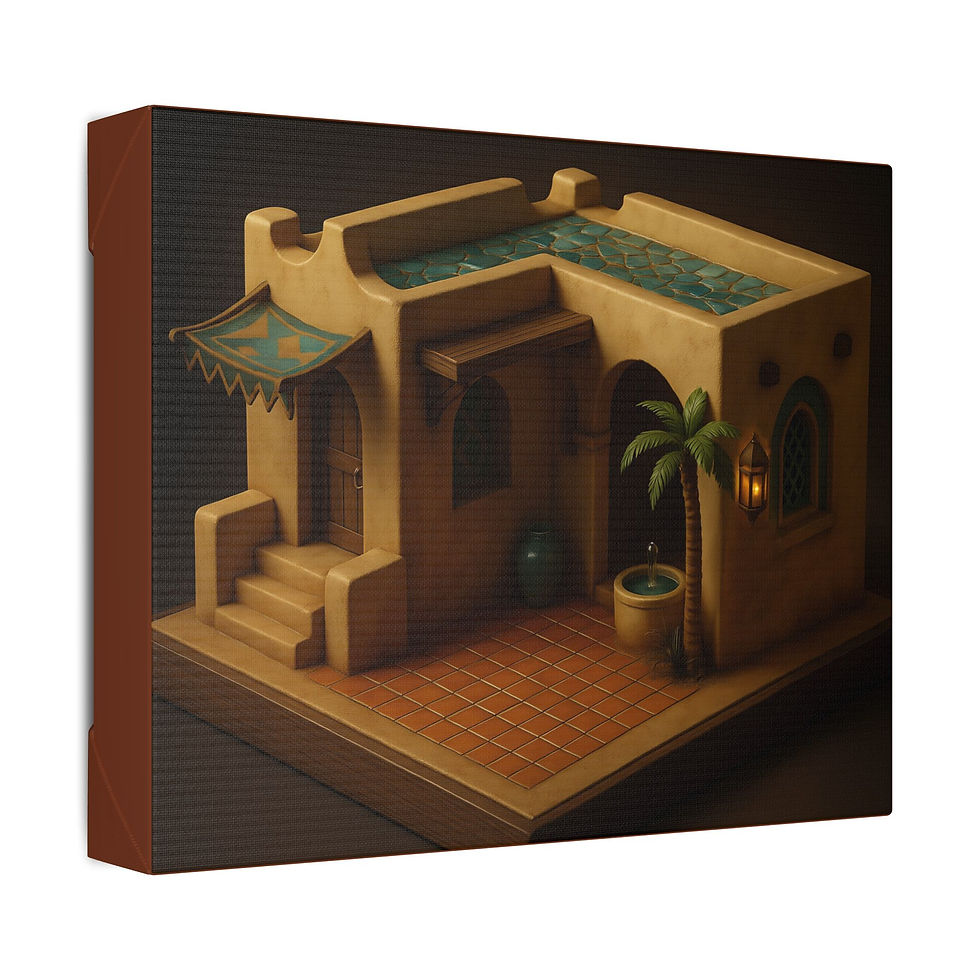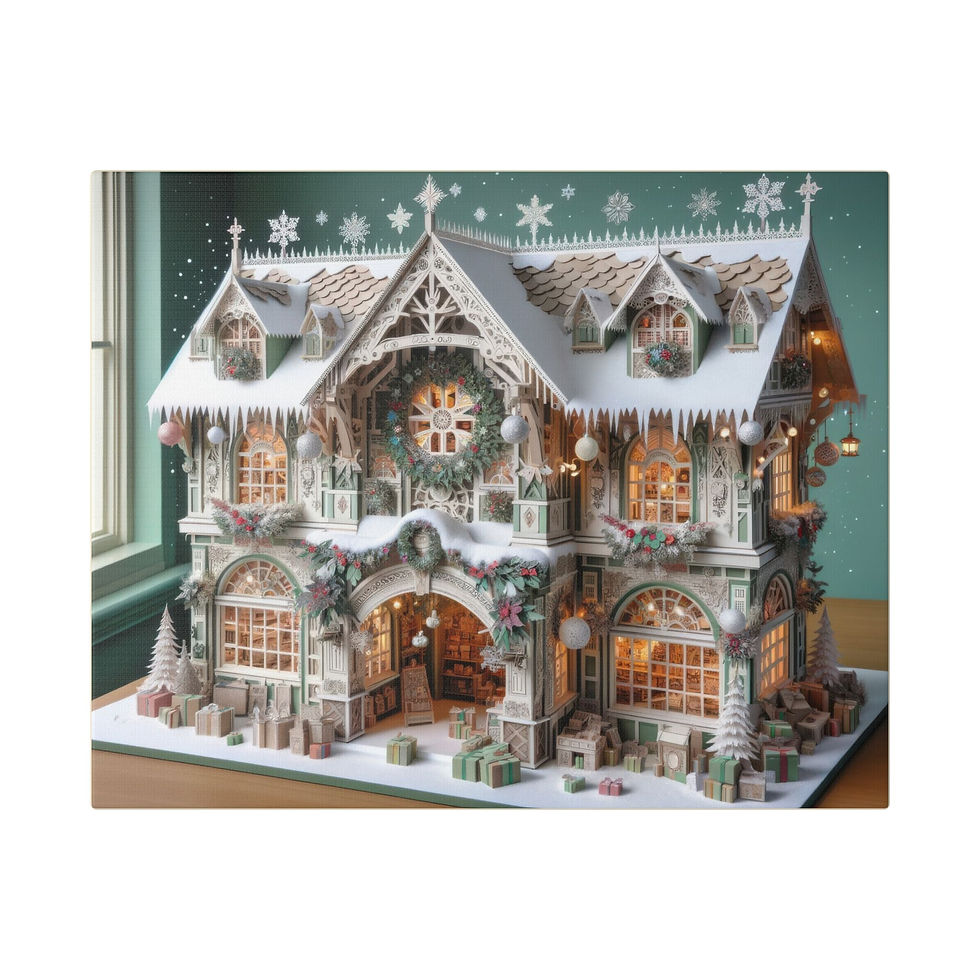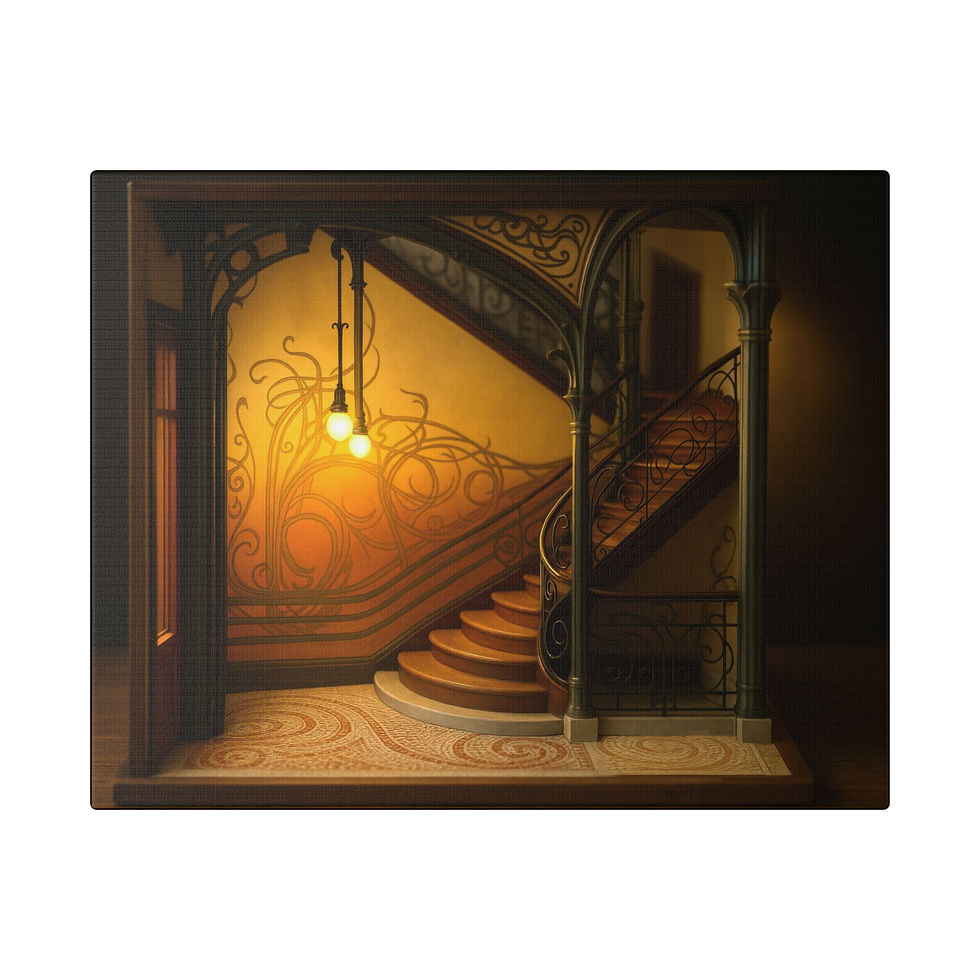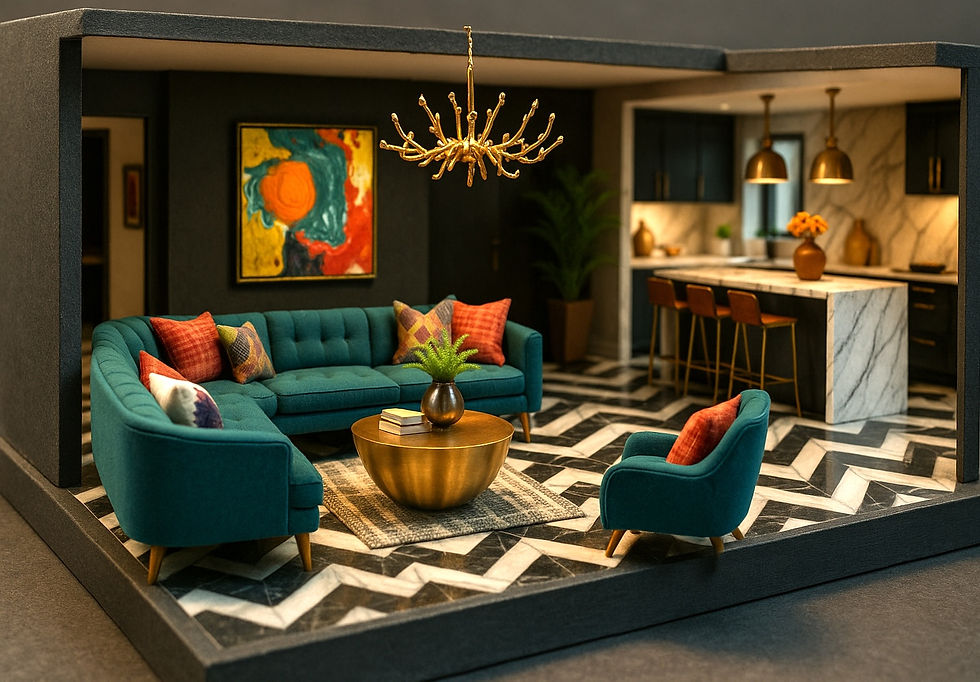The Quiet Hedgehog of Thimblewick: A Miniature Reading Nook With Big Feelings
- Brandon

- Aug 21
- 8 min read
Updated: 7 days ago
Hello from the small side of town! I’m Brandon, and today’s star is a 1:12 scale, cozy reading nook where our hedgehog hero curls up with the morning paper, a steaming cup, and an attitude that says, “Please keep your drama outside the miniature Victorian bay window.”
The scene leans Arts & Crafts with a dash of whimsical cottage: carved wood cabinets, Gothic arched windows, filament-style lamps, well-thumbed books, and that plush green wingback chair that practically sighs when you sit in it. Textures run the show—pebbled glaze on a succulent pot, woolly cloak, wood plank flooring with faint saw marks, and a rug so small it makes me giggle every time I vacuum the workbench.
The light is intentionally syrupy: amber bulbs, a little backlight from the right window, and a gentle bounce off the rug to keep our hedgehog’s face bright. If you’re hunting keywords, you just found them naturally: dollhouse diorama hedgehog, miniature reading room, tiny library scene, and handmade scale furniture. If you’re hunting joy, you also found it.
Why This Photo Gets VIP Treatment
A quick production note from your friendly neighborhood miniature wrangler: this blog photo is web-optimized for fast loading and sharing. It’s crisp for the internet but not “stare-at-it-from-two-inches” print sharp. If you want the full luxurious treatment on your wall, I’ve prepared a high-resolution canvas print with rich, true-to-color detail and FREE U.S. shipping. The hedgehog’s expression was born to hang above a reading chair—your reading chair, maybe? (Tea stains optional; I won’t judge.) https://www.smallworldminiatures.com/product-page/the-quiet-hedgehog-of-thimblewick-canvas-print
The Tiny Tale: Who Lives Here?
Welcome to Thimblewick, a pocket borough famous for its annual Leaf-Roll Derby and a municipal policy requiring at least three lamps per reading corner. The resident you see is Professor Percival Prickleworth, retired cartographer and columnist for The Bramble Times. He first mapped the Lost Saucer of Mrs. Tigby-Winkle in 1897 (don’t @ me, archivists), and now he spends mornings solving cryptograms and evenings filing stern yet fair letters to the editor about hedge etiquette.

Easter egg alert: squint at the newspaper headline—there’s a classified listing for a “Missing teaspoon, last seen near the jam.” That’ll come back later. The professor swears teaspoons evolve legs, but only when jam is involved. Chasing that whimsy helped me choose certain props—more on how lore drives design in the build notes.
Composition & Materials: A Walkthrough of the Build
Let’s stroll left to right:
Left wall cabinet: Basswood box (1/16" sheet) with carved doors made from polymer clay stamps. Two tiny succulents (air-dry clay over wire armatures) add green punctuation. The wall sconce is a brass eyelet with a 3mm warm-white LED tucked inside a rice-bead diffuser (snipped from a craft necklace).

Arched window & pendant: The arch is laser-cut MDF (you can fake it with layered cardstock), glazed with clear acetate scuffed by 0000 steel wool for a diffused pane. Pendant cord is black thread over 36-gauge magnet wire; housing is a bead cap.
Back wall gallery: Frames from balsa strip, 3D-printed moulding curls (or grab scrapbook filigree). The painting is a tea-stained index card with a whisper of sepia watercolor for a romantic fog.

Center stage, the wingback: The chair is built around a foam-core skeleton; the rolled wings are 2mm craft foam heat-shaped and wrapped in a suede-textured microfiber. Feet are turned from toothpicks; they’re 7mm tall so the chair height reads right against the hedgehog.
Professor Prickleworth: Needle-felted core with polymer clay paws and a resin nose. Spines? That’s a trimmed toothbrush head, painted Burnt Umber + a 3:1 mix of Black to Raw Umber for depth, dry-brushed with Titanium White + a pinch of Yellow Ochre for warmth.
Side table: 1.25" diameter top (coin template!) with dowel legs. The cup and saucer are polymer clay; the steam is teased hot-glue (stretch, cut, poke—repeat) set with matte varnish dusting.

Right built-ins and window: Stacked books are painted basswood offcuts wrapped in washi tape spines. The miniature Gothic arch window mirrors the left for visual rhythm, framing a subtler cool light to contour the silhouette.
Floor and rug: Popsicle sticks stained with a 1:1 mix of walnut ink and isopropyl alcohol yield the plank tone; nail holes dotted with a 0.3mm pen. Rug is printed cotton backed with hairspray to stiffen the weave, edged with embroidery floss fringe trimmed to 2mm.

Each prop supports the story: the handwarming tea, the cloak draped just so, the neatly folded paper. The “missing teaspoon” is tucked inside the little drawer by his elbow, as any good mystery should be.
Artist Tips – Make Your Own Magic
Pull up a magnifier—today you turn a handful of scraps into a room that smells like books and cinnamon. You’re not just building furniture; you’re teaching light how to behave.
Inspirations – From the Big World to the Small
This room borrows proudly from the Arts & Crafts family tree: honest materials, handcrafted joinery, warm light. Think William Morris patterns distilled into wood grain and bookish calm. The arched windows nod (miniature-sized) to Charles Rennie Mackintosh’s elegant verticals—geometry softened by craft. On the literary side, a tip of the cap to Beatrix Potter’s hedgehog heroine; while the palette is my own, the “tidy creature amid gentle chaos” vibe is pure Mrs. Tiggy-Winkle DNA. In miniature, those influences compress into readable shapes: chunkier mouldings, exaggerated textures, and overscaled lamp filaments so they read at arm’s length without losing charm.

Mini Shopping List (clever reuses first)
Coffee stirrers → floor planks & trim
Hairspray → fabric stiffener
Teabag (used/dried) → paper aging & washes
Toothbrush head (trimmed) → hedgehog spines texture
Beads & bead caps → lamp housings and diffusers
Foil from a chocolate wrapper → tiny spoon bowls
Embroidery thread → faux fabric cords + tassels
Cardstock + acetate → windows & frames
Basswood or popsicle sticks → furniture bones
Magnet wire (30–36 AWG) → invisible lighting runs
Walnut ink → wood stain magic
Matte & gloss varnish → finish control
Quick Wins
Shadow sandwich: Place your hero piece between a warm lamp and a cooler window. Instant depth, no LUTs required.
Tea time tint: Dab cold black tea as a glaze on paper props for believable age without muddy paint.
Thread → wiring cloak: Hide LED magnet wire inside black embroidery thread; twist once to suggest a cloth cord.
Toothpick lathe: Chuck a toothpick into a hobby drill and shape table legs with a nail file.
Rug wrangle: Stiffen fabric with hairspray, then iron between parchment paper for crisp edges.

Deep Dive
Planning & Scale: Sketch the footprint: a 6" x 4" x 5" room (WxDxH) frames a cozy reading vignette. In 1:12 scale, a 2" chair seat equals a 24" real seat—great for hedgehog ergonomics and human cuteness.

Bones (Base Structure): Foam-core walls glued into a u-shape, hardwood floor over a 1/8" MDF base. Pin-stripe the corners with 1/8" basswood to hide seams. Prime with gray rattle-can primer for even tooth.

Mini Wingback: — Build it yourself (or adopt a pre-made and give your glue a day off)
Targets: seat top 1.75" high; seat ~2.25" W × 1.75–2.0" D; legs 7 mm.
Skeleton:
Foam-core seat box 2.0" × 1.75" with 0.5" apron.
Back panel 2.0" × 1.75", lean 12–15°.
Arm blocks: taper from 0.6" front to 0.4" back.
Wings:
Cut from 2 mm craft foam; heat-curve; glue from arm top to mid-back.
Legs & Height:
Turn toothpick legs to 7 mm.
Cushion blank: foam 0.5" thick.
Dry-fit: legs + box + cushion (+ 1 mm shims if needed) = 1.75".
If hedgehog knees float → add a 1 mm shim under cushion.

Upholster (oversize pieces, pull tight underneath):
Inside back → seat deck → inside arms → inside wings → outside wrap.
Trim only on the underside; clip while drying. Optional piping: waxed thread.

Finish:
Glue legs square; test sit.
Nudge color to the blog green with Sap Green 3 : Prussian Blue 1 glaze if needed.

Utilities / Greebles: Doorknobs from brads; hinges drawn with a 0.5mm pen and shaded with Payne’s Grey. Spice up flat shelves with micro “greebles”: rolled paper scrolls, seed beads as jar lids, and the famous teaspoon prop: cut a spoon bowl from thin aluminum foil and glue to a sewing pin.

Furniture / Soft Goods: Tables and cabinets: basswood or coffee-stirrer laminates. For the cloak, cut felt on the bias; mist with water and drape while drying to get natural folds. A 3:1 PVA-to-water mix works as a “gravity gel” to set drapes.

Base Colors & Materials: Wood recipe: Raw Umber 2 parts + Burnt Sienna 1 part + a glaze of Payne’s Grey in corners. Green chair mix: Sap Green 3 parts + Prussian Blue 1 part + a fingertip of Ivory Black, knocked back with a satin varnish.

Weathering Stack (10 steps, primer → varnish)
Prime everything medium gray.
Zenithal dust with white from above (keeps values honest).
Base coats (wood, fabric, paper).
Acrylic wash (Sepia 1:6 with water) into panel lines.
Dry-brush edges with a lighter tone (wood: add Buff).
Stain pass using walnut ink on high-touch zones (cup rings!).
Pigment rub (Burnt Umber + Black) on floor seams.
Micro-chips with a 000 brush and Raw Umber.
Unifying glaze (Transparent Oxide Brown 1:10 medium) across wood.
Finish with matte varnish; hit the lamps and cup with gloss for contrast.

Lighting (temps, diffusion, wiring basics): Use warm-white LEDs (2700–3000K) for bulbs and a cooler window wash (5000K) behind tracing paper to fake overcast daylight. Diffuse lamps with scuffed beads or a dab of UV-resin thinned with alcohol. For wiring, a 5V USB pack. Keep joins heat-shrunk or varnish-sealed, and always test before gluing.

Safety: ventilate while soldering or spraying, wear nitrile gloves for resin/inks, eye protection when cutting, and always use the correct resistor with your LEDs to avoid heat.
Story Clutter / Easter Eggs: Add the teaspoon mystery: place a tiny spoon half-peeking from a drawer and write a matching classified ad for the paper. Include a pressed clover in a book and a micro ticket stub under the chair leg (balance wedge!).

Unifying Glaze / Finish: A final camera-driven pass: mist the room with a very light Transparent Oxide Brown glaze (1:15 medium) to equalize warmth, then spot-glaze the window with Payne’s Grey (1:20) to keep the outside cool.

Photo Tips:
Shoot at f/8–f/11 to keep the hedgehog crisp while letting the far wall soften.
Key light: a softbox at 45°; practical lamps ON for glow.
White balance to the paper; nudge +200K warmer if the rug goes cold.
A 1/4 Black Pro-Mist (or a nylon stocking over the lens hood) gives dreamy bloom.

Troubleshooting: Problem → Fix
Flat wood grain? Add a thin Payne’s Grey filter in the corners, then re-dry-brush Buff across the grain.
LED hotspots? Slip a 2–3mm circle of vellum inside the shade or scratch the bead interior with sandpaper.
Shiny fabric reads plastic? Dust with matte pigment and seal with ultra-matte varnish.
Chair looks too big? Lower the seat by 3–4mm and shorten feet to 6mm—scale reads instantly better.
Paper props curling? Brush the back with the same tea wash; let the fibers expand equally.
Until Next Time in the Small World
Professor Prickleworth found his missing teaspoon, by the way. He’d been using it as a bookmark. (We stan a resourceful academic.) If a detail in this scene made you smile—the steam curl, the soft elbows on the chair, the newspaper headline—tell me which one in the comments. And if you’re building your own cozy corner, please share it with #smallworldminiatures so I can applaud wildly and inevitably ask, “What’s in your tiny drawers?” For behind-the-scenes builds, freebies, and first dibs on new pieces, sign up for the newsletter—it’s where the best secrets hide.
Hashtags
#miniature #diorama #dollhouse #miniatureart #miniaturemaking #miniaturefurniture #scale1to12 #miniaturephotography #artsandcraftsstyle #victorianminiatures #booknook #cozyvibes #handcrafted #tinyart #modelmaking #dioramabuilders #ledlighting #tabletopcrafts #miniaturecollector #makersgonnamake #hobbycraft #kitbash #polymerclay #woodworking #paintingminiatures #weathering #storytelling #beatrixpotterinspired #smallworldminiatures







































Comments